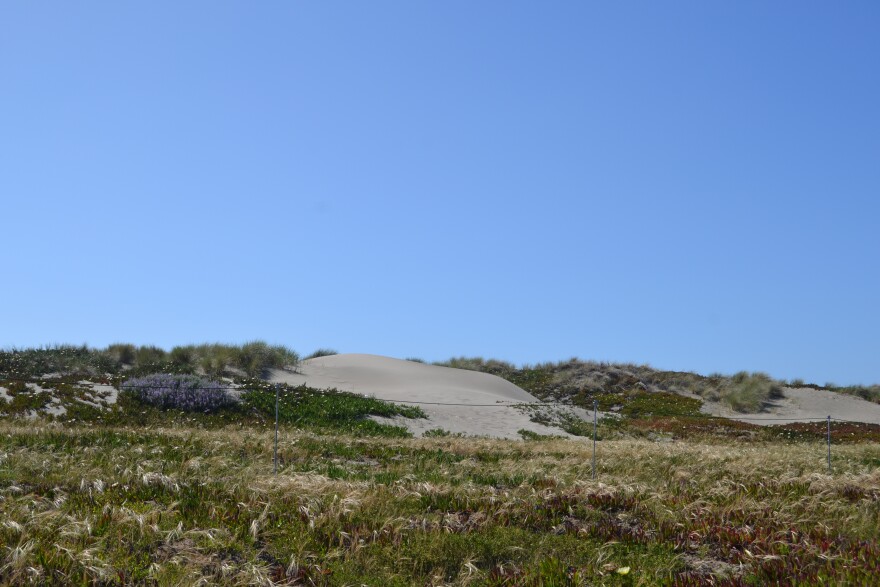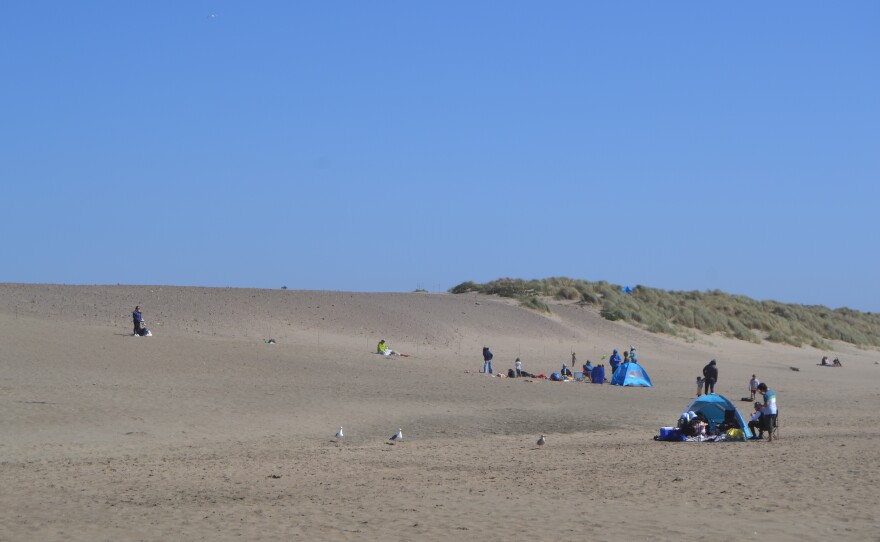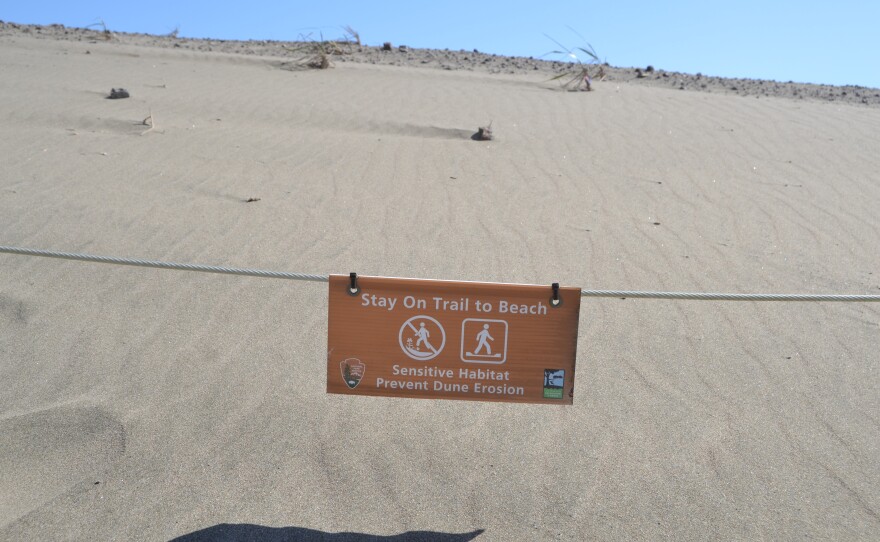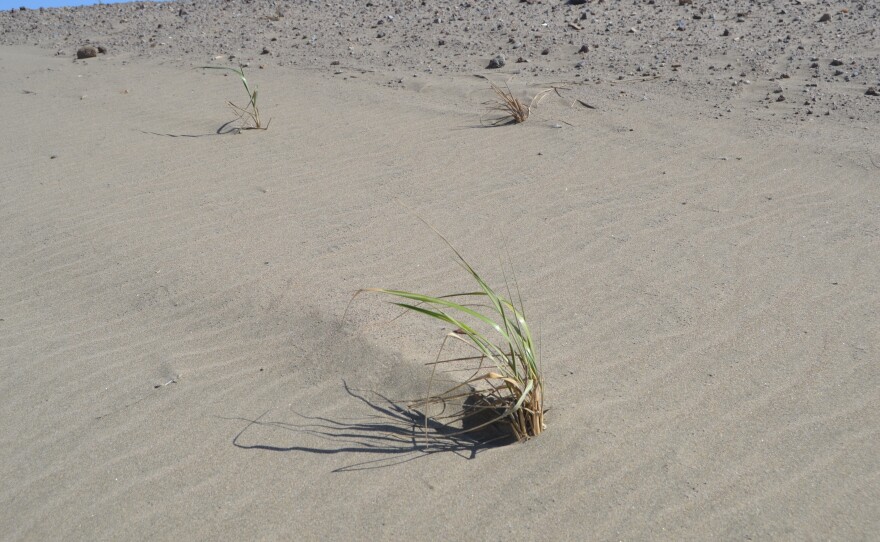This story aired in the July 28, 2025 episode of Crosscurrents.
Click the button above to listen.
Today, we have part six in a seven part series looking at sea level rise in California. From the San Diego / Tijuana Border all the way up to Humboldt Bay, we’re visiting some of the people and places that are dealing with flooding, coastal erosion, and pollution… all made worse by rising tides.
Last year, San Francisco voters said yes to Prop K: A ballot measure to permanently close the Great Highway on the west side of the city, and turn it into a park.
Proponents of Prop K argued that coastal erosion and sea level rise would eventually make The Great Highway undrivable. Advocates saw it as an opportunity to adapt, rather than resist that reality.
KALW’s emergency and disaster preparedness reporter, Wren Farrell visited the new park on opening day to learn more.
GINSBURG: Ladies and gentlemen, boys and girls, welcome to Sunset Dunes!
Cheering, clapping
REPORTER: Despite the drama surrounding its inception, Sunset Dunes felt like a big outdoor party on opening day.
GINSBURG: My name is Phil Ginsburg, I am the general manager of your San Francisco Recreation and Parks Department!
REPORTER: More than 10,000 people packed the old Great Highway.
SUNSET COMMUNITY BAND MUSIC
REPORTER: The Sunset Community Band played live music. Kids jumped in bouncy houses and waited in line to get their faces painted. Even Joel Engardio, the Sunset Supervisor who’s facing a recall over his support of the park, was grinning, as he cut a ribbon next to a furry mascot of the Western Snowy Plover.
ENGARDIO: I believe Sunset Dunes will benefit our Sunset neighborhoods for generations to come.
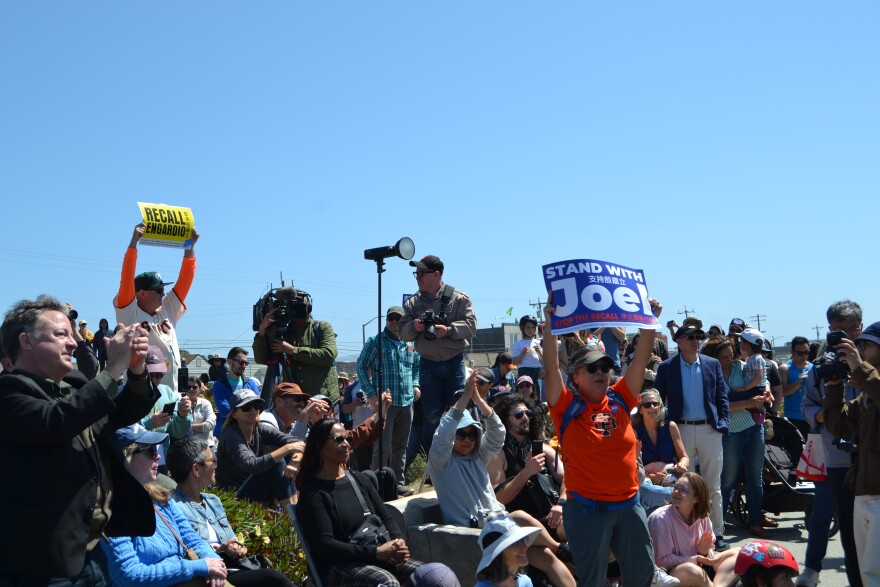
REPORTER: That benefit isn’t just about having a new park in San Francisco. Again and again, speakers brought up climate change. Like Dr. Kate Hucklebridge.
HUCKLEBRIDGE: This beach, like so many up and down California's coastline, is in danger of disappearing…
REPORTER: She’s the executive director of the California Coastal Commission — the state agency that’s basically in charge of California’s coastline.
HUCKLEBRIDGE: … If we don't take action to address the devastating impacts of climate change and sea level rise.
REPORTER: And so in addition to the speeches and festivities, there were walking tours with local experts who got to show us what the city and Coastal Commission are doing about it.
DAVENPORT: One of the major reasons they built the Great Highway was 'cause they wanted to control the ocean and the sand.
REPORTER: Like this one, with coastal erosion researcher Chase Davenport.
DAVENPORT: They wanted to develop this area and they could not do it unless they had something trying to hold back the sea and the sand.
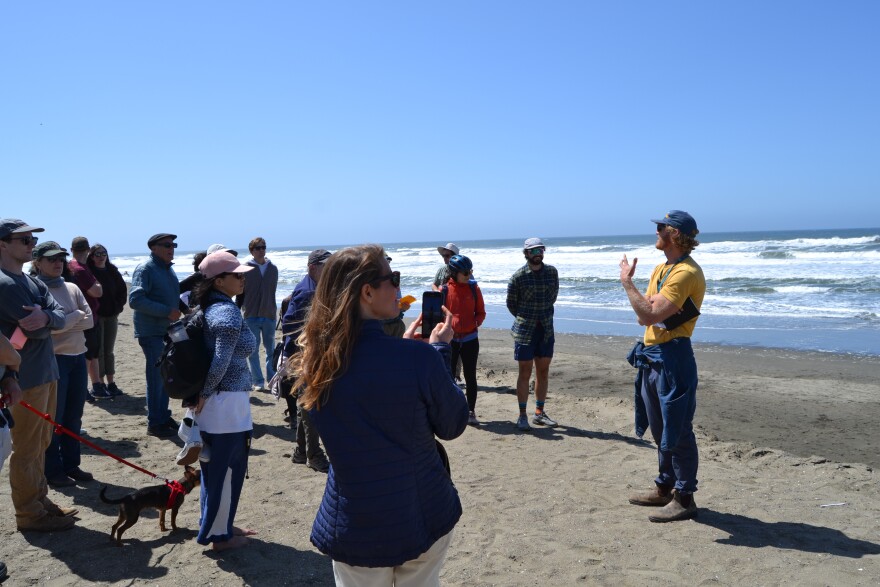
REPORTER: He led more than 50 people on a tour / history lesson through Sunset Dunes: During the Gold Rush era, much of the natural terrain of what is now San Francisco was made of up sand dunes. They stretched all the way from Ocean Beach to the Financial District, some as tall as 80 feet. In the mid 19th-century the dunes were leveled to make way for development. And later, the shoreline was even pushed back 200 feet west, to make way for the Great Highway and other construction. But the ocean keeps pushing back towards the city.
Davenport says that for decades, the city has been struggling to figure out how to protect its important coastal infrastructure from the wind and the encroaching sea. Like the Oceanside treatment plant that was built in the 90’s and serves the entire west side of the city.
DAVENPORT: And basically within four years of building this sewage treatment plant, it was starting to erode. And like six years after building it, they declared the first of many states of emergencies where they were basically like, what are we gonna do about this? We have sewage infrastructure running through a 14 foot wide pipe and it's like feet from the ocean.
REPORTER: They built a sea wall to protect the plant, but eventually the elements destroyed it. So they built another one, which was also destroyed. So they started trucking in sand, and creating artificial dunes. A strong dune can serve as a natural barrier between the ocean and the land.
DAVENPORT: And that's what you're standing on right now is this is where they've been taking all those dump trucks full of sand and dumping it. This is an engineered dune.
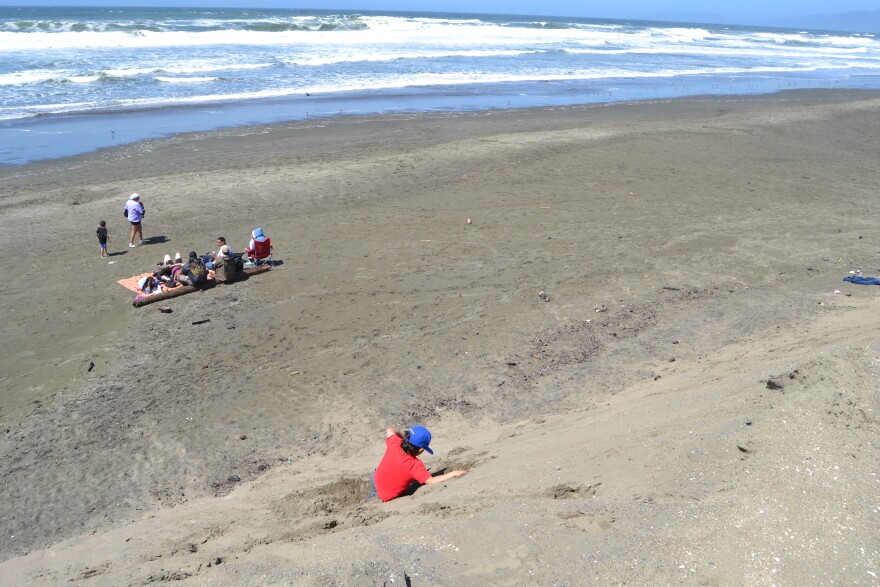
REPORTER: But engineered dunes don’t last as long. Dunes rely on the root systems of the plants that grow on them to be stable. Without plants, all the sand tends to just wash away during high tides or heavy rain.
DAVENPORT: And that's why the beach is disappearing right here. If you look, we have beach, beach, beach, beach, beach, beach, beach, beach, beach. And then right at this corner we've got no more beach.
REPORTER: Davenport says seawalls and engineered dunes are an ineffective and expensive way to protect some of the city’s most important infrastructure. But the city is experimenting with other ways to prevent coastal erosion.
Back in February, it started a dune restabilization project at a small section of the beach further North.
BRASTOW: Alright, spread around everybody so we can get a nice semi semicircle here again.
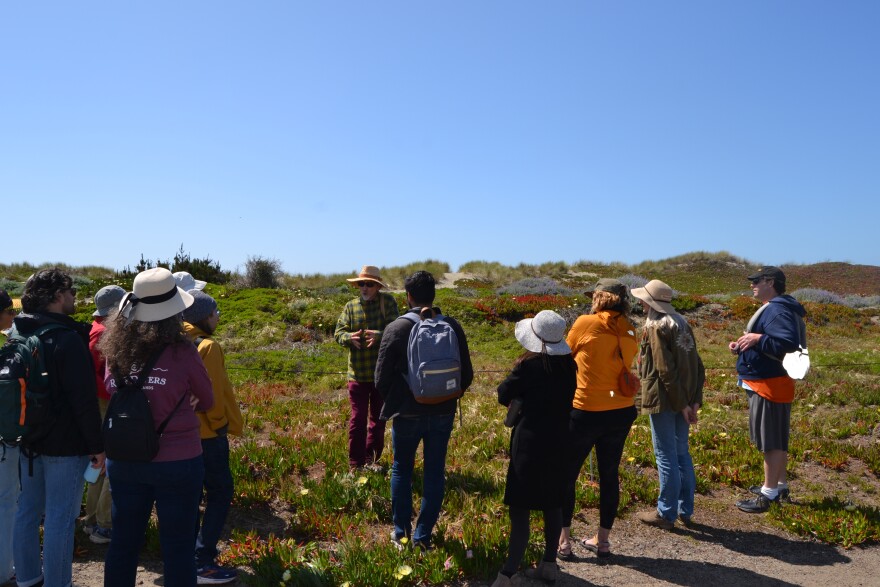
REPORTER: This is Peter Brastow.
BRASTOW: “Hey there.”
“Hi there.”
“How you doing? Hey Ron. All right. Come on. Get over here.”
“Don't wanna spoil any vegetation.”
“It's all right. Just don't step on that clarity bush. That's what, that's why we stopped here. I'm gonna talk about the vegetation a little bit.”
REPORTER: Brastow’s the senior biodiversity specialist at the San Francisco Environment Department. After Davenport’s talk, he led a tour to check on the progress of some newly planted dune grass.
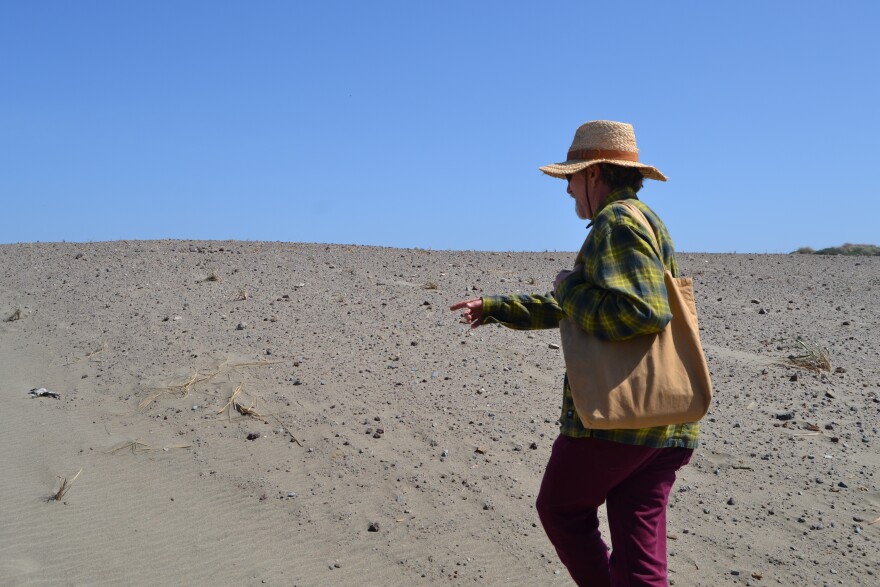
BRASTOW: We came over here and we had a whole kind of like, assembly line, right? We had people kind of spread out all over here, and we had bags and we had water. And so we would use shovels to dig out the American dune grass, right? And then quickly stick it in the bag out of the sun and out of the wind with a little bit of water to make sure it stayed moist from here to there. And so then the same day we had everybody planting over here. So we had people digging up here and then people planting it over there.
REPORTER: The American dune grass Brastow’s talking about is also called American dune wild-rye, and it’s growing right alongside a non-native grass, called European beachgrass.
BRASTOW: So you see all that kind of tufts of grass on the top of the dunes there?
REPORTER: Like any good biodiversity specialist would, Brastow points out the differences between the two, which to an untrained eye might be easy to miss.
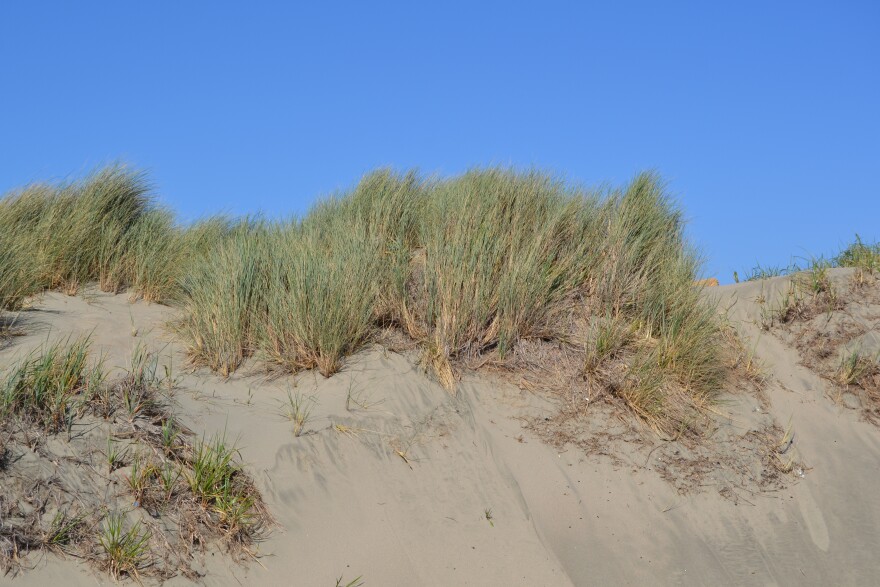
BRASTOW: That's Ammophila arenaria is the scientific name, or European beach grass. So, that was planted by the Park Service back in the 1980s to stabilize the dunes along Ocean Beach at Baker Beach.
REPORTER: But it's become a problem here. It crowds out native vegetation and limits species diversity. On top of that, it’s not as good at preventing erosion as the native stuff.
BRASTOW: The non-native seems to create these kind of erosion escarpments, whereas the native just creates this really nice just kind of blended dune from the beach up to the 20 feet of dune or so.
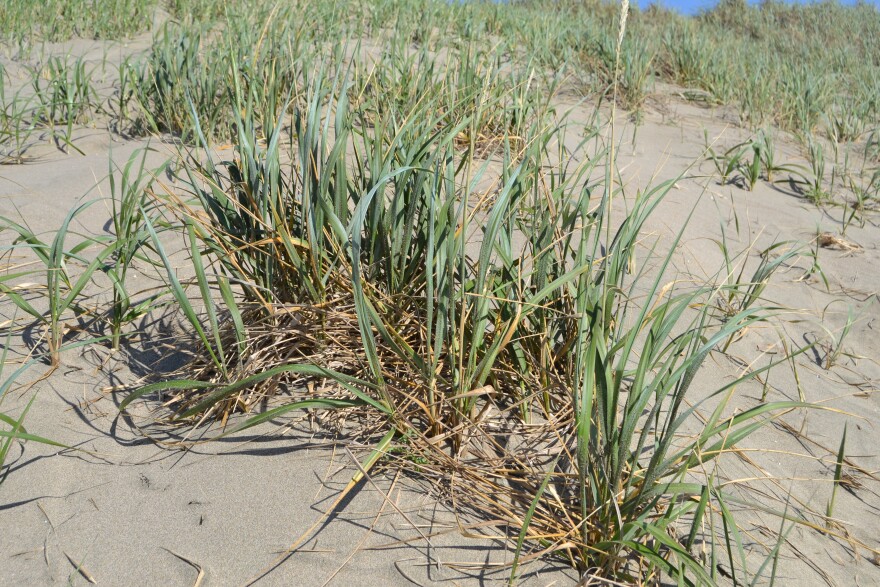
REPORTER: At first glance, the dune off Judah they’re trying to revegetate looks barren and rocky. I’m looking for upright, green sprouts, but all I see are tufts of brown that look flat and dead. But Brastow perks up when we get to the dune.
BRASTOW: I see green blades up there, so. I think some of them have made it.
REPORTER: What are, what are you looking at?
BRASTOW: Just these little tufts of grass, including this one right here. But mostly up there.
REPORTER: Even that one right there?
BRASTOW: Yeah. Uh-huh. Yep.
REPORTER: Wow. They're easy to miss.
BRASTOW: Yeah, definitely.
REPORTER: There’s a thin metal wire surrounding the dune, and signs every hundred feet or so warning people to stay off of them while the plants are growing.
BRASTOW: All right, we'll stop here for a second and then we're gonna walk further up the beach. Just a few more meters. Um, let's see. Can you see any green on this one? No. Um, but you can see green grass, little blade. So these are all American Dune grass or Beach Wild Rye is another common name. The scientific name is Leymus mollis.
REPORTER: But this is just an experiment. Brastow says if things go well, over the next two years, the American dune grass should grow to full size. If they’re successful, they hope to restabilize other dunes at Ocean Beach. But they’ll still have to come up with other solutions.
DAVENPORT: I'm 1000% in favor of the revegetation, like the degree to which we can pull that off, that will transform our relationship with the sand and the dunes.
REPORTER: According to Chase Davenport, even with a strong dune system protecting the wastewater treatment plant, the city is eventually gonna have to move it inland. Something it’s done before.
DAVENPORT: It took about 20 years to move the sewage treatment plant from basically the end of Golden Gate Park where it used to be to here. So we're gonna need decades to move it, and so the sooner we start, the better.
REPORTER: Last year, the Coastal Commission approved a $175 million plan to build another sea wall. It’s supposed to be over 3000 feet long. Construction is slated to begin in late 2026.


